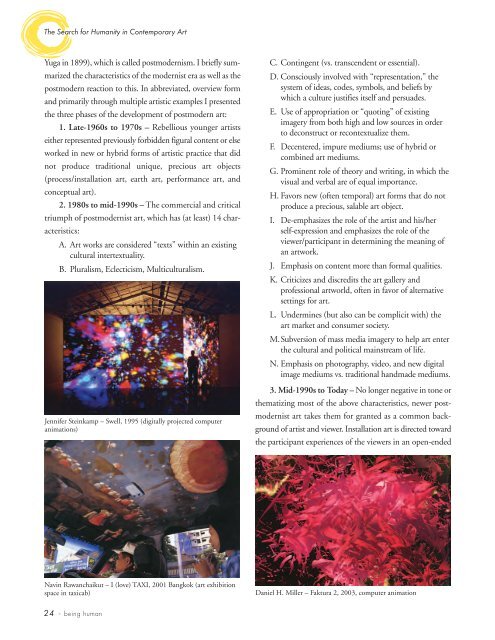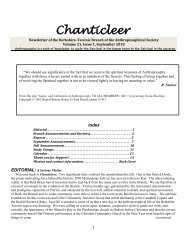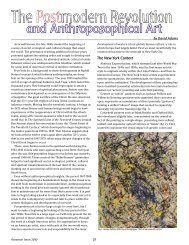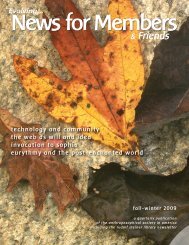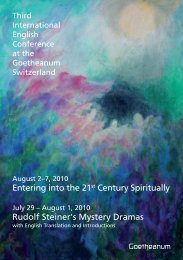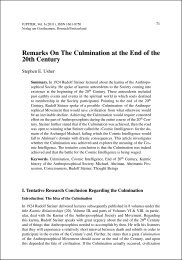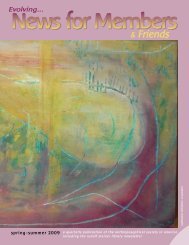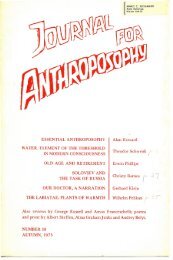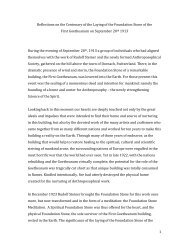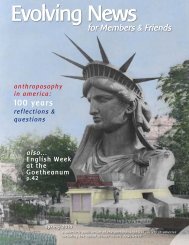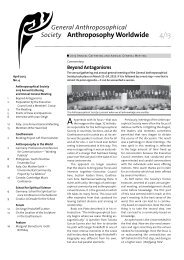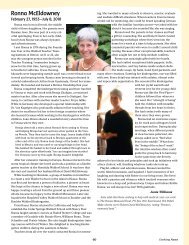Rudolf Steiner's Vision for the Future - Anthroposophical Society in ...
Rudolf Steiner's Vision for the Future - Anthroposophical Society in ...
Rudolf Steiner's Vision for the Future - Anthroposophical Society in ...
Create successful ePaper yourself
Turn your PDF publications into a flip-book with our unique Google optimized e-Paper software.
The Search <strong>for</strong> Humanity <strong>in</strong> Contemporary Art<br />
Yuga <strong>in</strong> 1899), which is called postmodernism. I briefly summarized<br />
<strong>the</strong> characteristics of <strong>the</strong> modernist era as well as <strong>the</strong><br />
postmodern reaction to this. In abbreviated, overview <strong>for</strong>m<br />
and primarily through multiple artistic examples I presented<br />
<strong>the</strong> three phases of <strong>the</strong> development of postmodern art:<br />
1. Late-1960s to 1970s – Rebellious younger artists<br />
ei<strong>the</strong>r represented previously <strong>for</strong>bidden figural content or else<br />
worked <strong>in</strong> new or hybrid <strong>for</strong>ms of artistic practice that did<br />
not produce traditional unique, precious art objects<br />
(process/<strong>in</strong>stallation art, earth art, per<strong>for</strong>mance art, and<br />
conceptual art).<br />
2. 1980s to mid-1990s – The commercial and critical<br />
triumph of postmodernist art, which has (at least) 14 characteristics:<br />
A. Art works are considered “texts” with<strong>in</strong> an exist<strong>in</strong>g<br />
cultural <strong>in</strong>tertextuality.<br />
B. Pluralism, Eclecticism, Multiculturalism.<br />
Jennifer Ste<strong>in</strong>kamp – Swell, 1995 (digitally projected computer<br />
animations)<br />
24 • be<strong>in</strong>g human<br />
C. Cont<strong>in</strong>gent (vs. transcendent or essential).<br />
D. Consciously <strong>in</strong>volved with “representation,” <strong>the</strong><br />
system of ideas, codes, symbols, and beliefs by<br />
which a culture justifies itself and persuades.<br />
E. Use of appropriation or “quot<strong>in</strong>g” of exist<strong>in</strong>g<br />
imagery from both high and low sources <strong>in</strong> order<br />
to deconstruct or recontextualize <strong>the</strong>m.<br />
F. Decentered, impure mediums; use of hybrid or<br />
comb<strong>in</strong>ed art mediums.<br />
G. Prom<strong>in</strong>ent role of <strong>the</strong>ory and writ<strong>in</strong>g, <strong>in</strong> which <strong>the</strong><br />
visual and verbal are of equal importance.<br />
H. Favors new (often temporal) art <strong>for</strong>ms that do not<br />
produce a precious, salable art object.<br />
I. De-emphasizes <strong>the</strong> role of <strong>the</strong> artist and his/her<br />
self-expression and emphasizes <strong>the</strong> role of <strong>the</strong><br />
viewer/participant <strong>in</strong> determ<strong>in</strong><strong>in</strong>g <strong>the</strong> mean<strong>in</strong>g of<br />
an artwork.<br />
J. Emphasis on content more than <strong>for</strong>mal qualities.<br />
K. Criticizes and discredits <strong>the</strong> art gallery and<br />
professional artworld, often <strong>in</strong> favor of alternative<br />
sett<strong>in</strong>gs <strong>for</strong> art.<br />
L. Underm<strong>in</strong>es (but also can be complicit with) <strong>the</strong><br />
art market and consumer society.<br />
M.Subversion of mass media imagery to help art enter<br />
<strong>the</strong> cultural and political ma<strong>in</strong>stream of life.<br />
N. Emphasis on photography, video, and new digital<br />
image mediums vs. traditional handmade mediums.<br />
3. Mid-1990s to Today – No longer negative <strong>in</strong> tone or<br />
<strong>the</strong>matiz<strong>in</strong>g most of <strong>the</strong> above characteristics, newer postmodernist<br />
art takes <strong>the</strong>m <strong>for</strong> granted as a common background<br />
of artist and viewer. Installation art is directed toward<br />
<strong>the</strong> participant experiences of <strong>the</strong> viewers <strong>in</strong> an open-ended<br />
Nav<strong>in</strong> Rawanchaikut – I (love) TAXI, 2001 Bangkok (art exhibition<br />
space <strong>in</strong> taxicab) Daniel H. Miller – Faktura 2, 2003, computer animation


